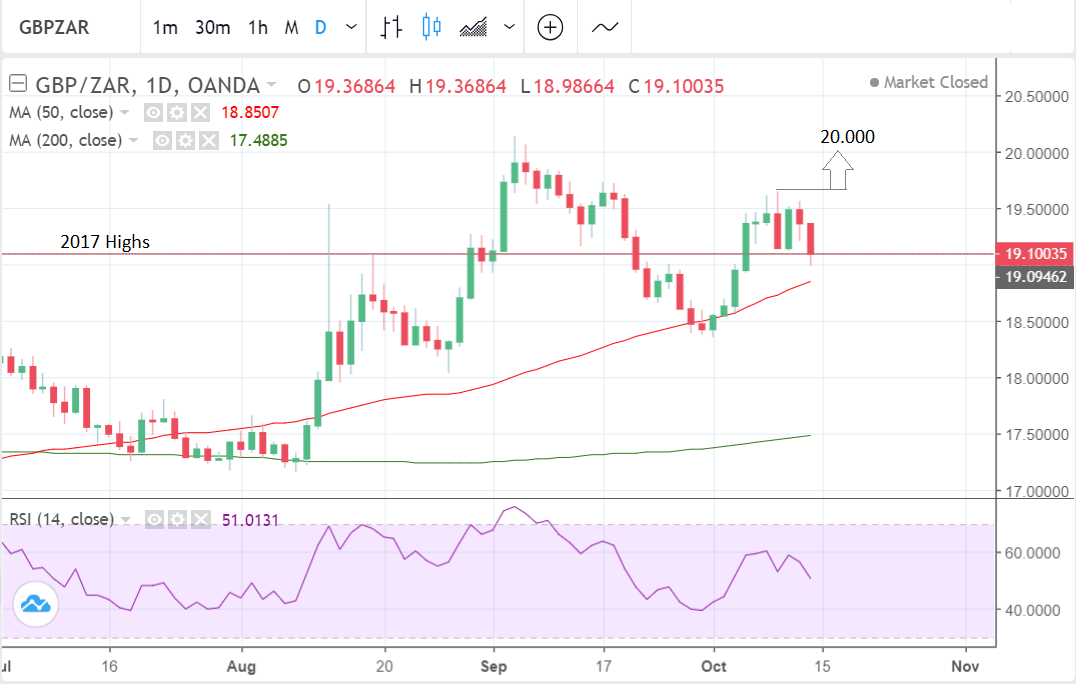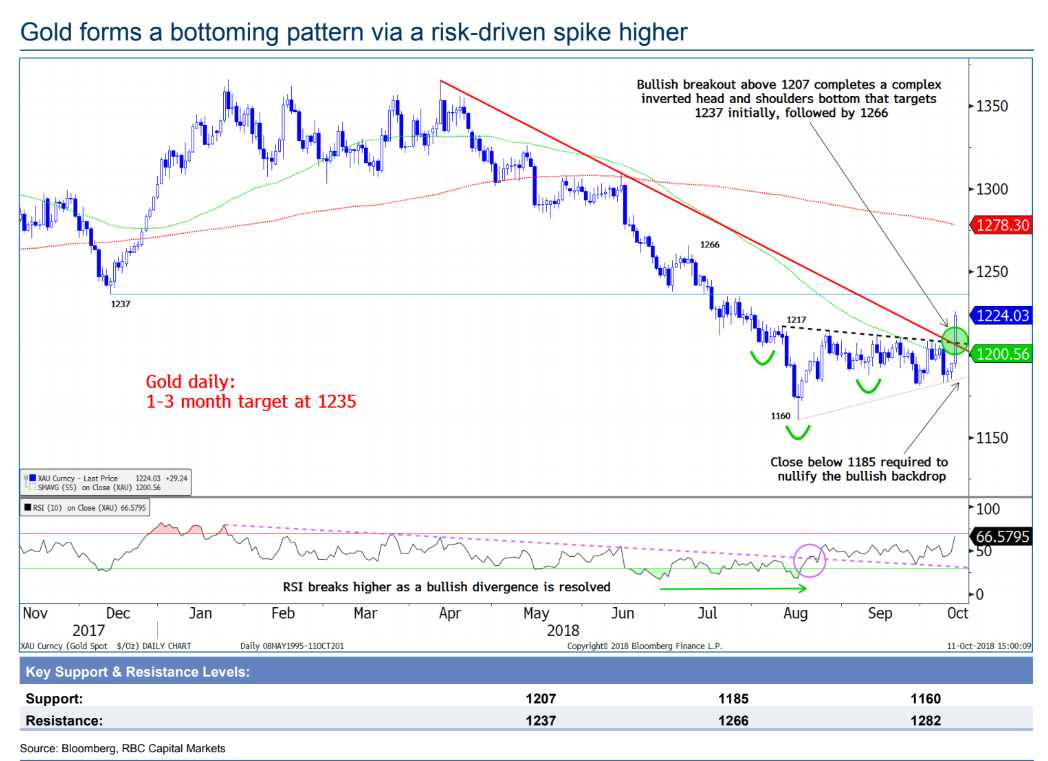South African Rand Volatility against the Pound Likely to Continue

Image © Government of South Africa
- GBP/ZAR in medium-term uptrend but volatility increases.
- Pair remains vulnerable to wide swings in the current market.
- Brexit dominates GBP, ZAR eyes internal and external factors.
Pound Sterling opens the new week lower against the Rand with the GBP/ZAR exchange rate quoted at 18.98 with Sterling seen broadly lower amidst news no Brexit deal is likely to be announced this week; something that will disappoint those traders who had been bidding the currency higher in anticipation of a breakthrough.
Domestically, the Rand leapt a ratings shaped hurdle Friday when Moody’s did not change the country's credit rating (or rating outlook).
Our understanding is that Moody’s has scope to change the rating (or outlook) if warranted after the South African government releases its next set of spending and taxation plans in the Medium Term Budget Policy Statement (MTBPS).
Domestic focus for ZAR now turns to the MTBPS due on October 24.
The Pound-to-South African Rand exchange rate remains in a technical uptrend but is to continue trading with volatile swings as news around Brexit and domestic politics buffet the exchange rate.

Above: Pound-to-Rand rate shown at daily intervals.
The weekly chart above shows how the exchange rate has been appreciating ever since the February lows, and this uptrend remains intact.
2018 highs would be a natural place to expect bulls to be drawn back into the market if there is going to be a continuation of this year's rally. Heavy buying could see the pair resume its medium-term uptrend in the week ahead.

Above: Pound-to-Rand rate shown at weekly intervals.
A break above the 19.64 highs might confirm a continuation higher, but movements in the exchange rate have been so random recently we are unable to make a call with any meaningful level of confidence.
Note too the lacklustre momentum highlighted by the Relative Strength Index (RSI), especially on the daily chart, which does not bode particularly well for those looking to see further gains. Of course this does not completely discount the possibility of more upside, but we remain cautious.
We prefer to stand aside this week as the indicators are mixed and there is too much risk of more volatility. We will consider updating with a forecast at such time as we are able.
Advertisement
Get up to 5% more foreign exchange by using a specialist provider to get closer to the real market rate and avoid the gaping spreads charged by your bank when providing currency. Learn more here
The South African Rand: What to Watch
Last week's main event passed by without much fanfare after Moody's delayed its latest decision on South Africa's credit rating, which is sat precariously at only one notch above "junk" status.
If Moody's lowers the rating it would spark a massive rout in SA assets, taking the Rand down along with it. Although the odds of a downgrade are small, according to Moody's themselves so this worst-case scenario is unlikely to materialise.
Moody's has not set a new date for the publication of their review, but most analysts say it will be after October 24 when the government publishes its Medium Term Budget Policy Statement (MTBPS).
The outlook for the week ahead is quiet from a domestic data perspective, so the Rand will probably take its cues from offshore factors instead.
The SA currency has a strong negative correlation with the U.S. Dollar so the direction of the greenback will be important for the Rand. The Dollar is currently losing ground as markets fear the U.S. economy will slow due to rising borrowing costs, however, whether this theme will see extended Dollar-weakness in the week ahead is difficult to determine.
Another factor that could drive price action in the Rand is the price of commodities such as gold. Gold surged last week after the US stock market broke lower, driving the price out of a bottoming pattern. If a new uptrend evolves for the precious metal it could be supportive of the Rand.

Above: Gold price. Source: RBC Capital Markets.
The Pound: What to Watch
Brexit headlines will continue to drive the Pound in the week ahead.
U.K. Brexit minister Dominic Raab will travel to Brussels on Monday for a meeting with E.U. chief negotiator Michel Barnier, probably to agree on the final proposals to put before E.U. leaders at their crunch summit on Wednesday, October 17-18.
The outcome of the summit is expected to be a key driver for the Pound in the week ahead. If there is concrete progress on a withdrawal deal Sterling is likely to surge higher; if, on the other hand, there is no progress the Pound will fall.
Analysts at FX broker XM are rather pessimistic about the possibility of a major breakthrough:
"As it is standard for all E.U. negotiations to last into the last minute, the remaining issues are unlikely to be resolved at the E.U. heads of government summit on October 17-18 and the talks will probably continue into November when a special summit is being planned."
XM adds that "a worst-case scenario would be for Prime Minister May to secure a deal that has little chance of getting approved by the British parliament."
Indeed, weekend headlines have been troubling for the Prime Minister with reports that the cabinet are being urged to stage a mutiny on May's plans.
The big problem lies with a backstop clause that would trigger if the E.U. and U.K. fail to reach a trade deal during the two year transition period. There is talk that the backstop could apply to the whole U.K. and not just Northern Ireland, as had been the original proposal.
It is believed that Prime Minister May is willing to allow this transition to last indefinitely; something fiercely opposed by Brexit supporting MPs in the Conservative party. Should a time limit be agreed the opposition to May might fade and she will be able to push legislation through parliament.
There are several major releases in the week ahead but probably the most important is broad inflation data in September, which is forecast to show a 2.6% rise compared to a year ago and a 0.2% rise compared to a month ago, when it is released on Wednesday at 9.30 B.S.T.
Core inflation, meanwhile, is forecast to show a 2.0% rise compared to a year ago.
Inflation informs central bank policy and, crucially for FX, whether they put up interest rates; these in turn impact on exchange rates. A higher-than-expected rise in inflation would increase pressure on the Bank of England to raise interest rates and support the Pound.
The other major release in the week ahead for the Pound is employment and wage data, out on Tuesday at 9.30.
The unemployment rate is expected to remain at 4.0% in August. Average pay excluding bonuses is expected to have climbed by 2.9%, and pay including bonuses to have increased by 2.6%.
Market participants will be particularly focused on whether pay has increased more than expected - if it has the Pound could rise - as this will raise the outlook for inflation.
The third major release for Sterling in the week ahead is retail sales out at 9.30 on Thursday.
Retail sales have been fairly resilient but in September they are forecast to show a -0.3% drop (from 0.3% in August) but, nevertheless, a 3.7% rise compared to September last year. A higher-than-expected result would probably support the Pound as it suggests greater growth, inflation, and higher interest rates which are usually favourable for a currency.
Finally the weekends with a speech by the governor of the Bank of England (BOE) Mark Carney on Friday, at 16.30, which has been earmarked by some as a possible time for the Uk authorities to announce progress on securing trade deal with the EU.
Advertisement
Get up to 5% more foreign exchange by using a specialist provider to get closer to the real market rate and avoid the gaping spreads charged by your bank when providing currency. Learn more here




